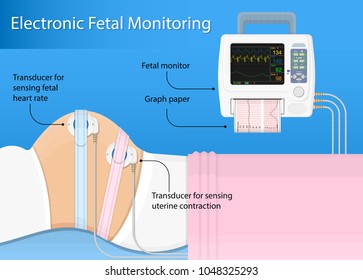
As the recognized leader in fetal heart monitoring education AWHONNs in-person and online formats are convenient evidence-based and the essential tools for educating the entire team. Electronic fetal monitoring.

What is continuous external electronic fetal monitoring like.
External electronic fetal monitoring. External electronic fetal monitoring Description External electronic fetal monitoring is an indirect noninvasive procedure involving the use of two devices an ultrasound transducer and a tocotransducer placed on the patients abdomen. It aids in evaluating fetal well-being and uterine contractions during labor. Electronic fetal monitoring EFM using cardiotocography is a common tool used during labor and delivery for assessment of fetal well-being.
It has largely replaced the use of intermittent auscultation and fetal scalp pH sampling. However data suggesting improved clinical outcomes with the use of E. The purpose of the NCC Electronic Fetal Monitoring Subspecialty Certification is to provide a competency-based examination that tests specialty knowledge and the application of that knowledge for licensed health care professionals in the US and Canada who utilize the application of electronic fetal monitoring and interpretation of data obtained to provide care to obstetrical patients in both inpatient.
Electronic fetal monitoring. Supplies more data about the fetus than auscultation Provides a record that can be printed or stored electronically Easy to identify trends in fetal heart rate and uterine activity Allows for one nurse to observe two laboring women Main disadvantage is reduced mobility for the mother External. Continuous electronic fetal monitoring was developed in the 1960s to assist in the diagnosis of fetal hypoxia during labor.
Continuous electronic fetal monitoring has been shown to reduce the. Intrapartum Electronic Fetal Monitoring Lisa A. Ruth Part 1 Introduction and Overview This module will provide clinicians with practical information on intrapartum fetal monitoring with a primary focus on electronic fetal monitoring EFM.
The module is divided into six sections. Part 1 provides an overview of intrapartum fetal monitoring and includes information. Auscultation of the fetal heart rate FHR is performed by external or internal means.
External monitoring is performed using a hand-held Doppler ultrasound probe to auscultate. As the recognized leader in fetal heart monitoring education AWHONNs in-person and online formats are convenient evidence-based and the essential tools for educating the entire team. 97 of students who participated in AWHONNs Fetal Heart Monitoring Program stated it would improve their ability to care for patients.
What is continuous external electronic fetal monitoring like. An electronic device called a transducer that is attached to wide stretchy bands will be placed around your abdomen. This device monitors your babys heartbeat.
Another device that tracks your contractions is usually attached to a second band around your abdomen. External fetal monitoring External fetal monitoring involves wrapping a device called a tocodynamometer around your stomach. A tocodynamometer uses high-frequency sound waves to measure your babys.
Electronic Fetal Monitoring can be external internal or both. With external monitoring a pair of belts are wrapped around your abdomen. One of the belts is using a Doppler to detect your babys heart rate and the other belt measures the length of contractions and the time between contractions.
Enjoy the videos and music you love upload original content and share it all with friends family and the world on YouTube. Uterine activity UA or UCs What happens to blow flow to the fetus. -decrease incidence of fetal death.
-increase cesecarian and va. -acquires signal human ear cannot hear. -interfaces w other te.
Monitor uterine muscle activity. What is an advantage of external electronic fetal monitoring. A Once correctly applied by the nurse the transducer need not be repositioned even when the woman changes positions.
B The tocotransducer can measure and record the frequency regularity intensity and approximate duration of uterine contractions UCs. C The external EFM does not require rupture of membranes or introduction of. It is harder to prove that electronic fetal monitoring can prevent rarer complications such as cerebral palsy or fetal death.
Continuous monitoring of your babys heart rate and your contractions is done by means of monitors strapped to your abdomen. External fetal monitoring graph. Electronic Fetal Monitoring - YouTube.
Why You Should Be Thinking About Your Blood Flow Redwood by UMZU.